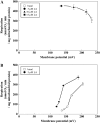Functional coexpression of the mitochondrial alternative oxidase and uncoupling protein underlies thermoregulation in the thermogenic florets of skunk cabbage
- PMID: 18162588
- PMCID: PMC2245847
- DOI: 10.1104/pp.107.113563
Functional coexpression of the mitochondrial alternative oxidase and uncoupling protein underlies thermoregulation in the thermogenic florets of skunk cabbage
Abstract
Two distinct mitochondrial energy dissipating systems, alternative oxidase (AOX) and uncoupling protein (UCP), have been implicated as crucial components of thermogenesis in plants and animals, respectively. To further clarify the physiological roles of AOX and UCP during homeothermic heat production in the thermogenic skunk cabbage (Symplocarpus renifolius), we identified the thermogenic cells and performed expression and functional analyses of these genes in this organism. Thermographic analysis combined with in situ hybridization revealed that the putative thermogenic cells surround the stamens in the florets of skunk cabbage and coexpress transcripts for SrAOX, encoding Symplocarpus AOX, and SrUCPb, encoding a novel UCP that lacks a fifth transmembrane segment. Mitochondria isolated from the thermogenic florets exhibited substantial linoleic acid (LA)-inducible uncoupling activities. Moreover, our results demonstrate that LA is capable of inhibiting the mitochondrial AOX pathway, whereas the proportion of pyruvate-stimulated AOX capacity was not significantly affected by LA. Intriguingly, the protein expression levels for SrAOX and SrUCPb were unaffected even when the ambient air temperatures increased from 10.3 degrees C to 23.1 degrees C or from 8.3 degrees C to 24.9 degrees C. Thus, our results suggest that functional coexpression of AOX and UCP underlies the molecular basis of heat production, and that posttranslational modifications of these proteins play a crucial role in regulating homeothermic heat production under conditions of natural ambient temperature fluctuations in skunk cabbage.
Figures








References
-
- Åkerman KE, Wikström MK (1976) Safranine as a probe of the mitochondrial membrane potential. FEBS Lett 68 191–197 - PubMed
-
- Boss O, Samec S, Paoloni-Giacobino A, Rossier C, Dulloo A, Seydoux J, Muzzin P, Giacobino JP (1997) Uncoupling protein-3: a new member of the mitochondrial carrier family with tissue-specific expression. FEBS Lett 408 39–42 - PubMed
-
- Clifton R, Millar AH, Whelan J (2006) Alternative oxidases in Arabidopsis: a comparative analysis of differential expression in the gene family provides new insights into function of non-phosphorylating bypasses. Biochim Biophys Acta 1757 730–741 - PubMed
Publication types
MeSH terms
Substances
LinkOut - more resources
Full Text Sources

